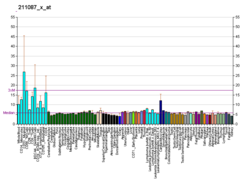Mitogen-activated protein kinase 14, also called p38-α, is an enzyme that in humans is encoded by the MAPK14 gene.[5]
MAPK14 encodes p38α mitogen-activated protein kinase (MAPK) which is the prototypic member of the p38 MAPK family. p38 MAPKs are also known as stress-activated serine/threonine-specific kinases (SAPKs). In addition to MAPK14 for p38α MAPK, the p38 MAPK family has three additional members, including MAPK11, MAPK12 and MAPK13 which encodes p38β MAPK, p38γ MAPK and p38δ MAPK isoforms, respectively. p38α MAPK was originally identified as a tyrosine phosphorylated protein detected in activated immune cell macrophages with an essential role in inflammatory cytokine induction, such as Tumor Necrotic Factor α (TNFα).[6][7] However, p38α MAPK mediated kinase activity has been implicated in many tissues beyond immune systems. p38α MAPK is mainly activated through MAPK kinase kinase cascades and exerts its biological function via downstream substrate phosphorylation. p38α MAPK is implicated in diverse cellular functions, from gene expression to programmed cell death through a network of signaling molecules and transcription factors. Pharmacological and genetic inhibition of p38α MAPK not only revealed its biological significance in physiological function but also the potential of targeting p38α MAPK in human disease such as immune disorders and heart failure.
- ^ a b c GRCh38: Ensembl release 89: ENSG00000112062 – Ensembl, May 2017
- ^ a b c GRCm38: Ensembl release 89: ENSMUSG00000053436 – Ensembl, May 2017
- ^ "Human PubMed Reference:". National Center for Biotechnology Information, U.S. National Library of Medicine.
- ^ "Mouse PubMed Reference:". National Center for Biotechnology Information, U.S. National Library of Medicine.
- ^ Lee JC, Laydon JT, McDonnell PC, Gallagher TF, Kumar S, Green D, McNulty D, Blumenthal MJ, Heys JR, Landvatter SW (January 1995). "A protein kinase involved in the regulation of inflammatory cytokine biosynthesis". Nature. 372 (6508): 739–46. doi:10.1038/372739a0. PMID 7997261. S2CID 4306822.
- ^ Han J, Lee JD, Bibbs L, Ulevitch RJ (Aug 1994). "A MAP kinase targeted by endotoxin and hyperosmolarity in mammalian cells". Science. 265 (5173): 808–11. Bibcode:1994Sci...265..808H. doi:10.1126/science.7914033. PMID 7914033.
- ^ Han J, Lee JD, Tobias PS, Ulevitch RJ (Nov 1993). "Endotoxin induces rapid protein tyrosine phosphorylation in 70Z/3 cells expressing CD14". The Journal of Biological Chemistry. 268 (33): 25009–14. doi:10.1016/S0021-9258(19)74564-5. PMID 7693711.







